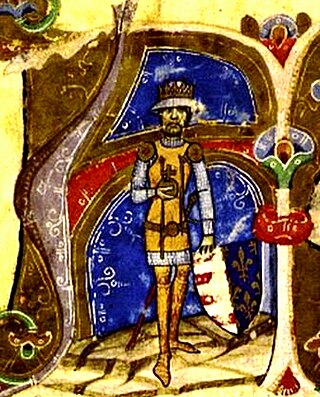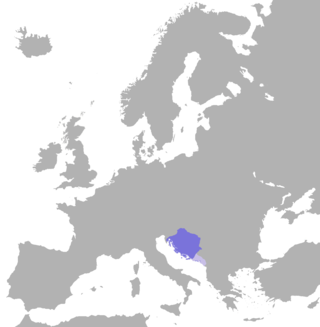
Andrew II, also known as Andrew of Jerusalem, was King of Hungary and Croatia between 1205 and 1235. He ruled the Principality of Halych from 1188 until 1189/1190, and again between 1208/1209 and 1210. He was the younger son of Béla III of Hungary, who entrusted him with the administration of the newly conquered Principality of Halych in 1188. Andrew's rule was unpopular, and the boyars expelled him. Béla III willed property and money to Andrew, obliging him to lead a crusade to the Holy Land. Instead, Andrew forced his elder brother, King Emeric of Hungary, to cede Croatia and Dalmatia as an appanage to him in 1197. The following year, Andrew occupied Hum.

Charles I, also known as Charles Robert was King of Hungary and Croatia from 1308 to his death. He was a member of the Capetian House of Anjou and the only son of Charles Martel, Prince of Salerno. His father was the eldest son of Charles II of Naples and Mary of Hungary. Mary laid claim to Hungary after her brother, Ladislaus IV of Hungary, died in 1290, but the Hungarian prelates and lords elected her cousin, Andrew III, king. Instead of abandoning her claim to Hungary, she transferred it to her son, Charles Martel, and after his death in 1295, to her grandson, Charles. On the other hand, her husband, Charles II of Naples, made their third son, Robert, heir to the Kingdom of Naples, thus disinheriting Charles.

Coloman the Learned, also the Book-Lover or the Bookish was King of Hungary from 1095 and King of Croatia from 1097 until his death. Because Coloman and his younger brother Álmos were underage when their father Géza I died, their uncle Ladislaus I ascended the throne in 1077. Ladislaus prepared Coloman—who was "half-blind and humpbacked", according to late medieval Hungarian chronicles—for a church career, and Coloman was eventually appointed bishop of Eger or Várad in the early 1090s. The dying King Ladislaus preferred Álmos to Coloman when nominating his heir in early 1095. Coloman fled from Hungary but returned around 19 July 1095 when his uncle died. He was crowned in early 1096; the circumstances of his accession to the throne are unknown. He granted the Hungarian Duchy—one-third of the Kingdom of Hungary—to Álmos.

A marten is a weasel-like mammal in the genus Martes within the subfamily Guloninae, in the family Mustelidae. They have bushy tails and large paws with partially retractile claws. The fur varies from yellowish to dark brown, depending on the species; it is valued by animal trappers for the fur trade. Martens are slender, agile animals, adapted to living in the taiga, which inhabit coniferous and northern deciduous forests across the Northern Hemisphere.

The kuna was the currency of Croatia from 30 May 1994 until 31 December 2022. It was replaced by the euro on 1 January 2023. It was subdivided into 100 lipa. The kuna was issued by the Croatian National Bank and the coins were minted by the Croatian Mint.

The Kingdom of Croatia entered a personal union with the Kingdom of Hungary in 1102, after a period of rule of kings from the Trpimirović and Svetoslavić dynasties and a succession crisis following the death of king Demetrius Zvonimir. With the coronation of King Coloman of Hungary as "King of Croatia and Dalmatia" in 1102 in Biograd, the realm passed to the Árpád dynasty until 1301, when the (male) line of the dynasty died out. Then, kings from the Capetian House of Anjou, who were also cognatic descendants of the Árpád kings, ruled the kingdoms. Later centuries were characterized by conflicts with the Mongols, who sacked Zagreb in 1242, competition with Venice for control over Dalmatian coastal cities, and internal warfare among Croatian nobility. Various individuals emerged during the period, such as Paul I Šubić of Bribir, who was representing the most powerful Croatian dynasty at the time, the Šubić noble family. These powerful individuals were on occasion able to de facto secure great deal of independence for their fiefdoms. The Ottoman incursion into Europe in the 16th century significantly reduced Croatian territories and left the country weak and divided. After the death of Louis II in 1526 during the Battle of Mohács and a brief period of dynastic dispute, both crowns passed to the Austrian House of Habsburg, and the realms became part of the Habsburg monarchy.

The Palatine of Hungary was the highest-ranking office in the Kingdom of Hungary from the beginning of the 11th century to 1848. Initially, Palatines were representatives of the monarchs, later the vice-regent (viceroy). In the early centuries of the kingdom, they were appointed by the king, and later were elected by the Diet of the Kingdom of Hungary. A Palatine's jurisdiction included only Hungary proper, in the Kingdom of Croatia until 1918 the ban held similar function as the highest office in the Kingdom, monarch's representative, commander of the royal army and viceroy.

The Kingdom of Croatia, or Croatian Kingdom, was a medieval kingdom in Southern Europe comprising most of what is today Croatia, as well as most of the modern-day Bosnia and Herzegovina. The Croatian Kingdom was ruled for part of its existence by ethnic dynasties, and the Kingdom existed as a sovereign state for nearly two centuries. Its existence was characterized by various conflicts and periods of peace or alliance with the Bulgarians, Byzantines, Hungarians, and competition with Venice for control over the eastern Adriatic coast. The goal of promoting the Croatian language in the religious service was initially introduced by the 10th century bishop Gregory of Nin, which resulted in a conflict with the Pope, later to be put down by him. In the second half of the 11th century Croatia managed to secure most coastal cities of Dalmatia with the collapse of Byzantine control over them. During this time the kingdom reached its peak under the rule of kings Peter Krešimir IV (1058–1074) and Demetrius Zvonimir (1075–1089).

Pacta conventa was an agreement concluded between King Coloman of Hungary and the Croatian nobility in 1102 or afterwards, defining the status of Croatia in the union with Hungary. The earliest manuscript of the document is of the fourteenth century, so some historians believe it is likely a forgery.

Coloman of Halych was the ruler—from 1214 prince, and from 1215 or 1216 to 1221 king—of Halych, and duke of Slavonia from 1226 to his death. He was the second son of Andrew II of Hungary and Gertrude of Merania. His father and Leszek the White, Duke of Poland, concluded an agreement about the marriage of Coloman and Leszek's daughter, Salomea, and the division of Halych, allotting its western regions to Leszek, the remaining lands to Coloman. The Hungarian and Polish armies occupied the principality in late 1214. Andrew II appointed a Hungarian nobleman, Benedict the Bald, to administer it on Coloman's behalf. Coloman was crowned the first king of Halych with the pope's authorization in early 1216.
Banovac, banski denar or banica is the name of a coin struck and used in Croatia between 1235 and 1384. The Latin name denarius banalis was derived from the words ban and denarius. The word ban is a title of nobility used in Croatia, and roughly translates as "viceroy", whereas denarius is Latin for coins minted by the Roman Empire.

A conditional noble or predialist was a landowner in the Kingdom of Hungary who was obliged to render specific services to his lord in return for his landholding, in contrast with a "true nobleman of the realm" who held his estates free of such services. Most conditional nobles lived in the border territories of the kingdom, including Slavonia and Transylvania, but some of their groups possessed lands in estates of Roman Catholic prelates. Certain groups of conditional nobility, including the "ecclesiastic nobles" and the "nobles of Turopolje" preserved their specific status until the 19th century.

The Kingdom of Hungary came into existence in Central Europe when Stephen I, Grand Prince of the Hungarians, was crowned king in 1000 or 1001. He reinforced central authority and forced his subjects to accept Christianity. Although all written sources emphasize only the role played by German and Italian knights and clerics in the process, a significant part of the Hungarian vocabulary for agriculture, religion, and state matters was taken from Slavic languages. Civil wars and pagan uprisings, along with attempts by the Holy Roman emperors to expand their authority over Hungary, jeopardized the new monarchy. The monarchy stabilized during the reigns of Ladislaus I (1077–1095) and Coloman (1095–1116). These rulers occupied Croatia and Dalmatia with the support of a part of the local population. Both realms retained their autonomous position. The successors of Ladislaus and Coloman—especially Béla II (1131–1141), Béla III (1176–1196), Andrew II (1205–1235), and Béla IV (1235–1270)—continued this policy of expansion towards the Balkan Peninsula and the lands east of the Carpathian Mountains, transforming their kingdom into one of the major powers of medieval Europe.

In the Late Middle Ages, the Kingdom of Hungary, a country in Central Europe, experienced a period of interregnum in the early 14th century. Royal power was restored under Charles I (1308–1342), a scion of the Capetian House of Anjou. Gold and silver mines opened in his reign produced about one third of the world's total production up until the 1490s. The kingdom reached the peak of its power under Louis the Great (1342–1382) who led military campaigns against Lithuania, southern Italy and other faraway territories.
The Duke of Slavonia, also Duke of Dalmatia and Croatia and sometimes Duke of "Whole Slavonia", Dalmatia and Croatia was a title of nobility granted several times in the 13th and 14th centuries, mainly to relatives of Hungarian monarchs or other noblemen. The title of duke signified a more extensive power than that of the Ban of Slavonia or Ban of Croatia.
Denis, son of Ampud, also Denis, son of Apod, was an influential baron in the Kingdom of Hungary in the first decades of the 13th century. He was Master of the treasury between 1216 and 1224. He was also ispán of at least three counties.
John Ernuszt, Sr. was Ban of Slavonia from 1473 to 1476. He was born into a Jewish family in Vienna. He moved to Buda, the capital of the Kingdom of Hungary, and converted to Roman Catholicism. He became a purveyor to the royal court, which enabled him to meet Matthias Corvinus, King of Hungary. His career in the administration of royal revenues began in 1461, with responsibility for the collection of the thirtieth in Pozsony County. He purchased copper mines in Upper Hungary in 1466.
The freemen's pennies or the pennies of freemen was a direct tax in the Kingdom of Hungary in the 11th-13th centuries.
This is a description of the current and historical currencies of Croatia, or historically used in the region. The currency of Croatia is the euro, in use since 2023.
Abraham from the kindred Tétény was a Hungarian noble in the first half of the 13th century, who administered counties during the reign of Andrew II of Hungary.












